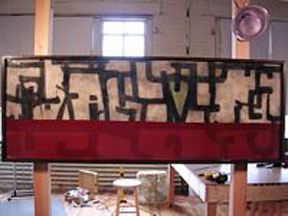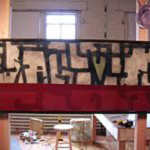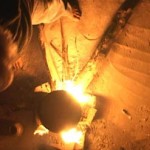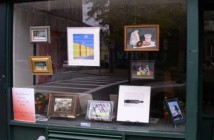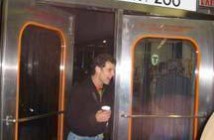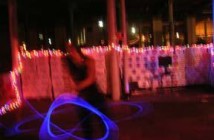The Open Studios Season is upon us. Metalic blue and gold streamers hang limp from walkup windows, inviting foot traffic in from the rain. Hand written signs offer encouragement and direction from walk-up floor to floor. Around Fort Point Channel alone, 250 artists open their doors and bait their studios with offerings of cheese and wine for the thousands of visitors decending on the neighborhood. The creative residents of these warehouses carry themselves with the air of successful colonists. Since 1978, a nucleus of artists has transformed this area into a center of expressive energy. They celebrate that success each fall, opening their doors to anyone who wants to stop by and see the bohemian terrariums where artists work.
Even among many artists who enjoy representation, Open Studios is an opportunity to sell work without the burden of a commission. Prices are listed high to satisfy the gallery overlords, but quickly collapse into private bargaining once an interest is expressed. As a result, the weekend long event has emerged as a low key but important viewing and buying opportunity for collectors around the country.
With 250 studios to visit, you take the good with the bad. To occupy a studio space subsidized by local and federal grant money, one must meet the standard of the Fort Point Arts Community, Inc., which requires that “working artists” use the spaces as primary work locations or residences. After a few hours, it becomes clear that this criterion is loosely defined and embraces everything from architects and web designers to painters, sculptors and the makers of printed cloth handbags. And yet, within this chorus of choices and options a few artists make an impression that lingers.
Timothy Kadish is young and excited. The core of works now on display at his 319 A Street Studio are striking in how they parallel their maker in that regard. One of the first statements out of his mouth is, “Go ahead, touch it.” This is reassuring, the surfaces of these paintings seems to demand more than just a visual sensibility. For Kadish, color and surface are concerns that trump image in his new series of mix media works that combine tightly scrolling line work with luminous yet durable epoxy varnishes. Upon first glance, these are accessible images, but an unsettling closer look pushes Kadish’s pictures to the edge of abstraction. Representation is replaced with a symbolic language largely of Kadish’s own making, yanking cartoonish shapes from context and reassembling into tangled, organic statements comfortably at odds with the finished, industrial sheen of his paintings.
Jim Kalambokis shows his work with a group a few floors below Kadish. His work is a more mature, thematically cogent group of sculptures, less tethered to their sources of inspiration than Kadish’s paintings. For Kalambokis, the sculptor’s material is not stone, but books. His tool is not a chisel, but irony. A copy of J. Edgar Hoover’s paranoid text, Masters of Deceipt, sits on display, its author’s hidden self exposed by the intaglio carving of Marilyn Monroe’s face into the cover and pages of the book. Patton’s War as I Knew It is similarly excavated into an image of a French prostitute. Other works are composites, allowing the arguments of Betty Freidan and Purchasing: Principles and Applications to collide in the intesecting form of a woman’s naked silloutette in a piece entitled, Purchasing the Feminine Mystique. A few of the works in this series are less compelling than others, but the best among them are funny and unexpectedly beautiful.
On Summer Street, Michael Sheridan’s brilliant video installations alone merit a visit to the Fort Point Channel. Sheridan’s politics are more constructive than most on display around the neighborhood. His focus is directly on dignity and survival. As such, food takes center stage in this series of videos, projected onto screens of coarse burlap, adding an arresting dimension of texture and smell to the work. Filmed in western India, Sheridan’s hours long film, Feeding the Fire, of a woman preparing the daily meal is projected from above and forms the center piece of a triptych, flanked by spiraling images of grinding grain. Another installation, again filmed directly from above, displays the frenetic pace of eating, sped up as plates of food ebb and flow throughout a family’s dinner table. For collectors touring the Open Studios, it’s nearly impossible to experience such video installations and not wonder how to display such a demanding art form in one’s own home, but these are questions any serious collector of contemporary art ought to address.
In spite of all this, an atmosphere of resigned valediction has crept into the Fort Point Channel area. On June 22, 2005, the Boston Globe reported that the investment firm of Goldman Sachs purchased the neighborhood’s remaining 17 buildings. Development plans are in motion, transforming these warehouses into commerical and high-end residential properties. The city’s oldest and largest arts community is already beginning to fracture on the news, with a vangard looking for studio space in South Boston, the South End and even outside the city. And so this colonial adventure is drawing to a close. Having revitalized Fort Point Channel, the resident artists find themselves priced out of the neighborhood and once again in search of new places to work.
Links:
Fort Point Arts Community - FPAC Online
Timothy Kadish
Jim Kalambokis
Michael Sheridan
"26th Annual Fort Point Open Studios" was on the weekend of October 14th in the Fort Point Channel area of Bosotn, MA
All images are courtesy of the artists.

